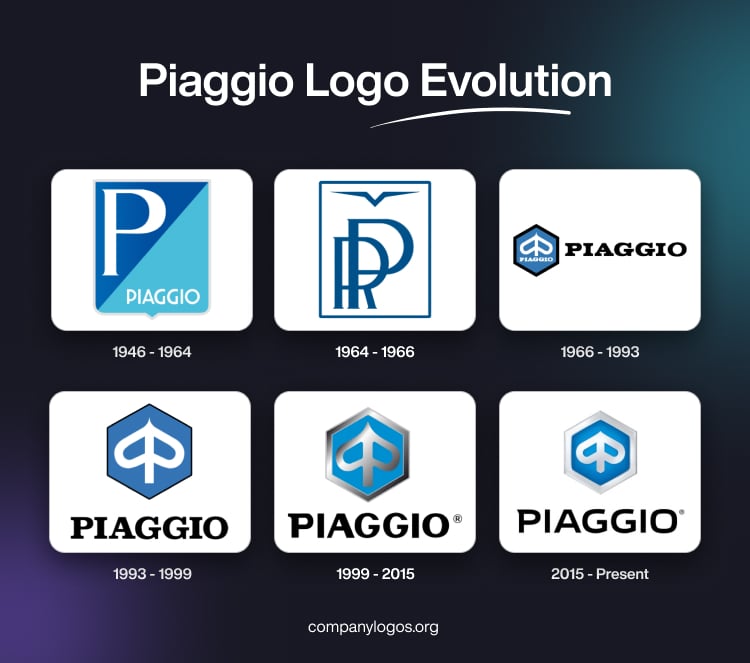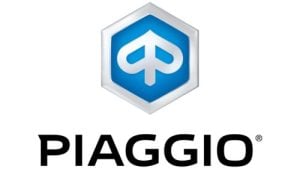
Piaggio is an Italian company known for producing motorcycles, scooters, and compact commercial vehicles. Established in 1884 by Ronaldo Piaggio, its iconic Vespa scooters are famed for efficiency, stylish design, reliability, and mobility. Its visual identity reflects the journey of the brand over the years. The article explores the evolution of the Piaggio logo since its inception, among other details about the company.
The Genesis of the Piaggio Logo (1884 – 1946) (Unavailable)
The original logo of Piaggio is not available in the public domain, and the history of the logo can only be explored from 1946 onwards.
(1946 – 1964)
The earliest available Piaggio logo was introduced in 1946 alongside the iconic Vespa. It featured a shield divided transversely into two fields. The upper portion displayed a bold “P” in a white sans-serif typeface in uppercase set against a blue background.
On the other hand, the lower portion displayed the Piaggio logotype in white uppercase against a lighter shade of blue. This design symbolised stability and forward movement, and it corresponded with Italy’s post-war optimism and Piaggio’s mission to provide affordable mobility.

(1964 – 1966)
In 1964, Piaggio adopted a monogram “PR” (Rinaldo Piaggio), coupled with a stylised bird to reflect its aeronautic roots. The logo featured a dark blue framing with a white background. The monogram was written in a dark blue colour right below an abstract triangular symbol that looked like a bird. However, this logo iteration was short-lived as the brand moved towards a design more fitting for motor vehicles.

(1966 – 1993)
The 1966 logo iteration saw the introduction of an emblem, alongside the lettering. The emblem comprised a stylised wasp that appeared similar to an inverted heart and a bold vertical line. Drawn in white against a calm blue background, the emblem had the hexagonal shape of a honeycomb with a thick black outline. The brand name to the right of the emblem in bold, black uppercase was rendered in a smooth serif typeface.

(1993 – 1999)
The size of the emblem was increased in the 1993 iteration and was placed right above a modified brand name in a black serif typeface. The honeycomb-shaped emblem with the white stylised wasp got a thinner outline in black compared to its earlier avatar.

(1999 – 2015)
In 1999, the ownership of the company changed, necessitating a new logo. Owned by the Morgan Grenfell Fund, the logo aimed to have a modern identity. So, the 1999 logo iteration saw the emblem turned three-dimensional with a thick silver outline.
The inverted heart inside the emblem was depicted in glossy gradient shades. The brand name underneath was rendered in black in large capital letters using a solid sans-serif typeface with geometrically clean contours. The only exception was the serif at the top corner of the letter “P.”

(2015 – Present)
The silver gradients became lighter for a clean, luminous look and provided greater focus on the bold blue hexagon. The wordmark executed in a custom sans-serif typeface remains beneath to emphasise modernity and sophistication. The pointed serif on top of the letter “P” resembles the wasp sting, and the letter “O” in square shape has rounded corners.

The Elements of the Piaggio Logo
Symbol
The Piaggio logo emblem features a hexagon to represent a honeycomb. The brand’s symbol, a stylised wasp, is formed from the two-letter “P” by placing them face to face. This emblem symbolises the heritage of the company in a stylish way.
Font
The Piaggio logo wordmark is executed using a custom sans-serif typeface. The letter “P” displays a pointed angle to resemble the wasp sting. Also, the square shape of the letter “O” has rounded corners.
Colour
The Piaggio logo colour palette comprises silver white and light blue for the emblem and black for the wordmark. The colours make the logo appear fresh and light and the brand professional and trustworthy. The black colour of the wordmark mirrors the power and authority of the company.
The History of Piaggio
Piaggio was founded in 1884 by twenty-year-old Rinaldo Piaggio in Sestri Ponente, Genoa. The venture began as a producer of ship fittings and quality furniture for the burgeoning Italian maritime industry. By the turn of the century, Piaggio had established a near-monopoly in ship interiors for the northwest Italian coast and expanded its reputation abroad. At that time, it used to furnish the cabins of more than 70 global shipping lines.
Not long thereafter, Rinaldo Piaggio sought new horizons and moved into producing railway carriages and components. This was made possible due to the company’s expertise in complex woodworking. In 1906, a new manufacturing facility opened in Finale Ligure, which enabled expansion in capabilities to trucks, trams, and even luxury automobiles.
The onset of the First World War prompted Piaggio’s entry into aviation. It began by repairing and building seaplanes and then progressed to original aircraft designs. This was possible after the company acquired aviation companies and key engineering talent. Under licenses from prominent manufacturers (Ansaldo, Macchi, Caproni, and Dornier), and later from its own designs, Piaggio produced a wide array of military hardware, including motorboats, seaplanes, and aircraft engines.
By the late 1930s, Piaggio had set 21 world records with its aircraft and engines. These included developing the four-engine Piaggio P.108 bomber. In fact, the main Pontedera factory became a strategic industrial site, which was later devastated in Allied bombings during the Second World War.
With Italy’s infrastructure in ruins after the Second World War, Rinaldo’s son Enrico Piaggio led a dramatic rebirth of the company by shifting focus to civilian personal transportation. He worked with the aeronautical engineer Corradino D’Ascanio to pioneer a revolutionary scooter, the Vespa. D’Ascanio’s MP6 prototype featured a monocoque chassis, direct-drive wheels, handlebar gearshift, and enclosed bodywork, which made it easy to ride and maintain.
Launched in 1946, the Vespa 98cc quickly became a symbol of postwar Italian ingenuity and freedom. Production skyrocketed from just 2,484 scooters in 1946 to over 171,200 in 1953. It was the popularity of Vespa that fuelled Piaggio’s return to prosperity. It helped establish it as a global brand, with manufacturing soon extending to 13 countries and sales in 114 nations.
Building on Vespa’s acclaim, Piaggio grew into a dominant European player in the scooter, motorcycle, and light vehicle markets. It introduced other landmark vehicles such as the Ape (a three-wheeled utility vehicle) and continued to produce light commercial trucks, like the modern Piaggio Porter.
Piaggio also expanded into electric and eco-friendly vehicles and consolidated its leadership by acquiring legendary Italian brands, including Aprilia, Moto Guzzi, and Derbi. The firm’s product range now spans from two-wheeled scooters and motorcycles to light aircraft and commercial vehicles.
Based in Pontedera, Tuscany, the Piaggio Group is a global company operating in over 50 countries and producing hundreds of thousands of vehicles annually. Its role in shaping both Italian and international mobility, in terms of ship cabins and luxury trains to iconic scooters and innovative commercial vehicles, remains central to its identity.
Interesting Facts About Piaggio
- Piaggio was founded in 1884 by Rinaldo Piaggio in Genoa, Italy, and it originally produced naval fittings, railroad cars, and aircraft.
- It only entered the scooter industry after the Second World War when Italy needed affordable transportation solutions.
- Piaggio launched the Vespa scooter in 1946, which quickly became a symbol of freedom and post-war mobility in Europe.
- The name “Vespa” means “wasp” in Italian. It was named so because of the buzzing sound of the scooter and its slim-waisted profile.
- The Vespa became a pop culture phenomenon. It appeared in classic movies like “Roman Holiday” (1953), starring Audrey Hepburn and Gregory Peck.
- Vespa clubs exist worldwide, and it remains a fashion and design icon, not just a vehicle.
- Piaggio owns several other well-known brands, including:
- Aprilia (sport motorcycles)
- Moto Guzzi (historic motorcycle brand, founded in 1921)
- Derbi and Gilera
- Piaggio’s Vespa was among the first scooters to feature a monocoque chassis, which makes it lightweight, durable, and easy to ride.
- Piaggio also developed the MP3, a three-wheeled scooter with a leaning front suspension, which offers enhanced safety and handling.
- Piaggio has dabbled in futuristic mobility solutions, including:
- Gita, an autonomous cargo-carrying robot.
- Piaggio Fast Forward, its US-based innovation arm that focuses on smart urban mobility.
- Piaggio entered the Indian market in the late 1990s and is well-known for:
- Piaggio Ape—a popular three-wheeler used for commercial transport.
- Vespa India – reintroduced in 2012 with premium scooters.
- Piaggio is headquartered in Pontedera, Tuscany, where the original Vespa was developed. The location also houses the Piaggio Museum, which showcases the company’s rich history.
- Piaggio is actively developing electric versions of its scooters, such as the Vespa Elettrica, to align with modern sustainability and urban mobility goals.
Finally
The logo evolution of Piaggio shows the brand’s journey from industrial shipbuilding to a global leader in innovative mobility. Each logo redesign has balanced modern appeal with deep roots in Italian history. The logo reflects values of originality, freedom, and ingenuity that define the enduring legacy of Piaggio.